Literature Review: Overweight, Weight Loss, and Intervention Programs
VerifiedAdded on 2022/12/30
|7
|1893
|3
Literature Review
AI Summary
This literature review examines the multifaceted issue of overweight and weight loss, synthesizing findings from various research articles published in recent years. The review defines overweight and obesity using the Body Mass Index (BMI) and highlights the growing prevalence of these conditions globally, emphasizing the role of unhealthy diets and lack of physical activity. It explores the health consequences of overweight, including diabetes, cardiovascular disorders, and other related issues. The review analyzes intervention programs and strategies, such as promoting healthy diets, physical activity, and providing education to address and manage overweight. It also discusses the importance of healthcare providers and government initiatives in raising awareness and providing support to individuals struggling with weight-related health concerns. The findings underscore the need for comprehensive approaches that combine dietary changes, exercise, and healthcare interventions to combat the rising rates of overweight and obesity and improve overall health outcomes.
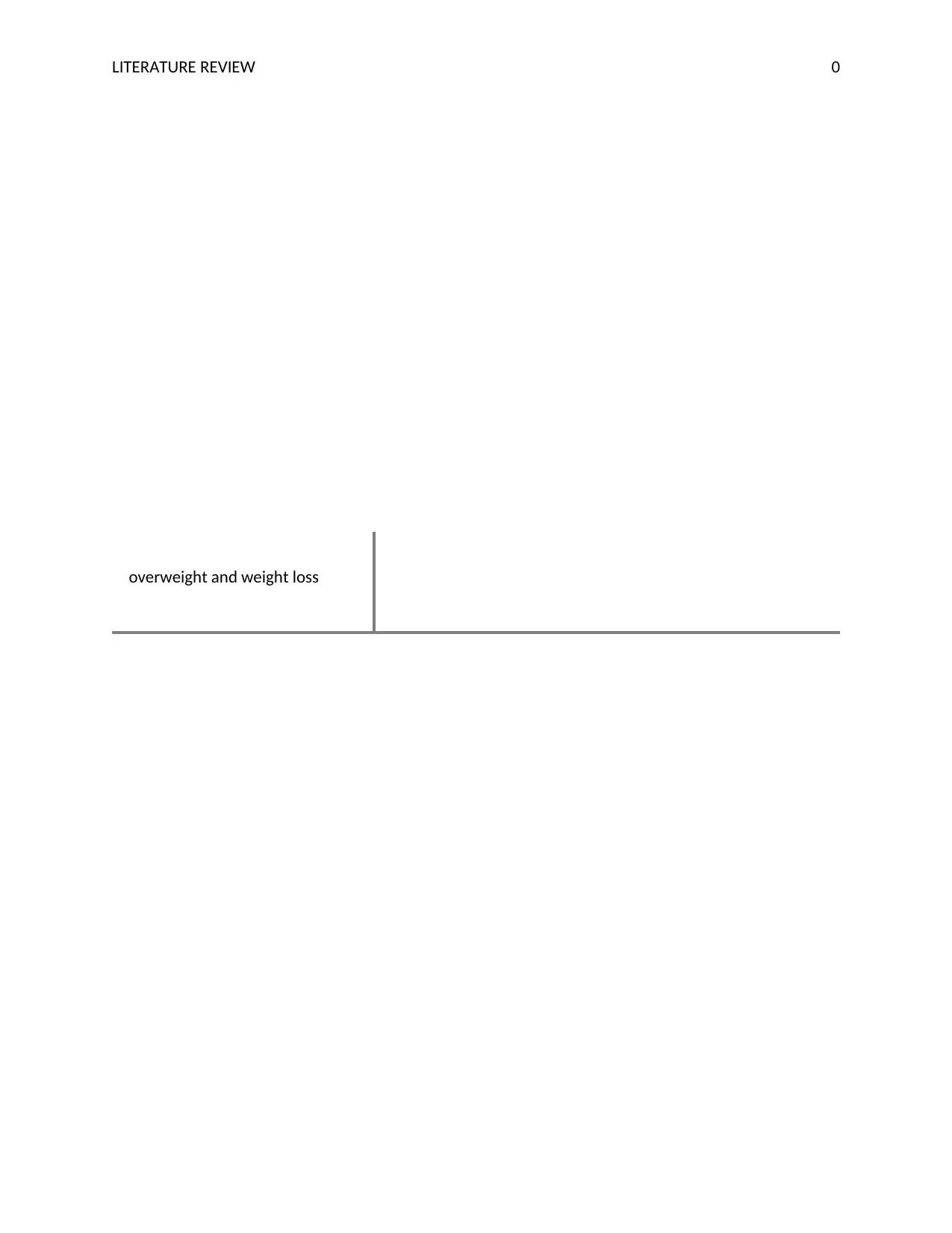
LITERATURE REVIEW 0
overweight and weight loss
overweight and weight loss
Paraphrase This Document
Need a fresh take? Get an instant paraphrase of this document with our AI Paraphraser
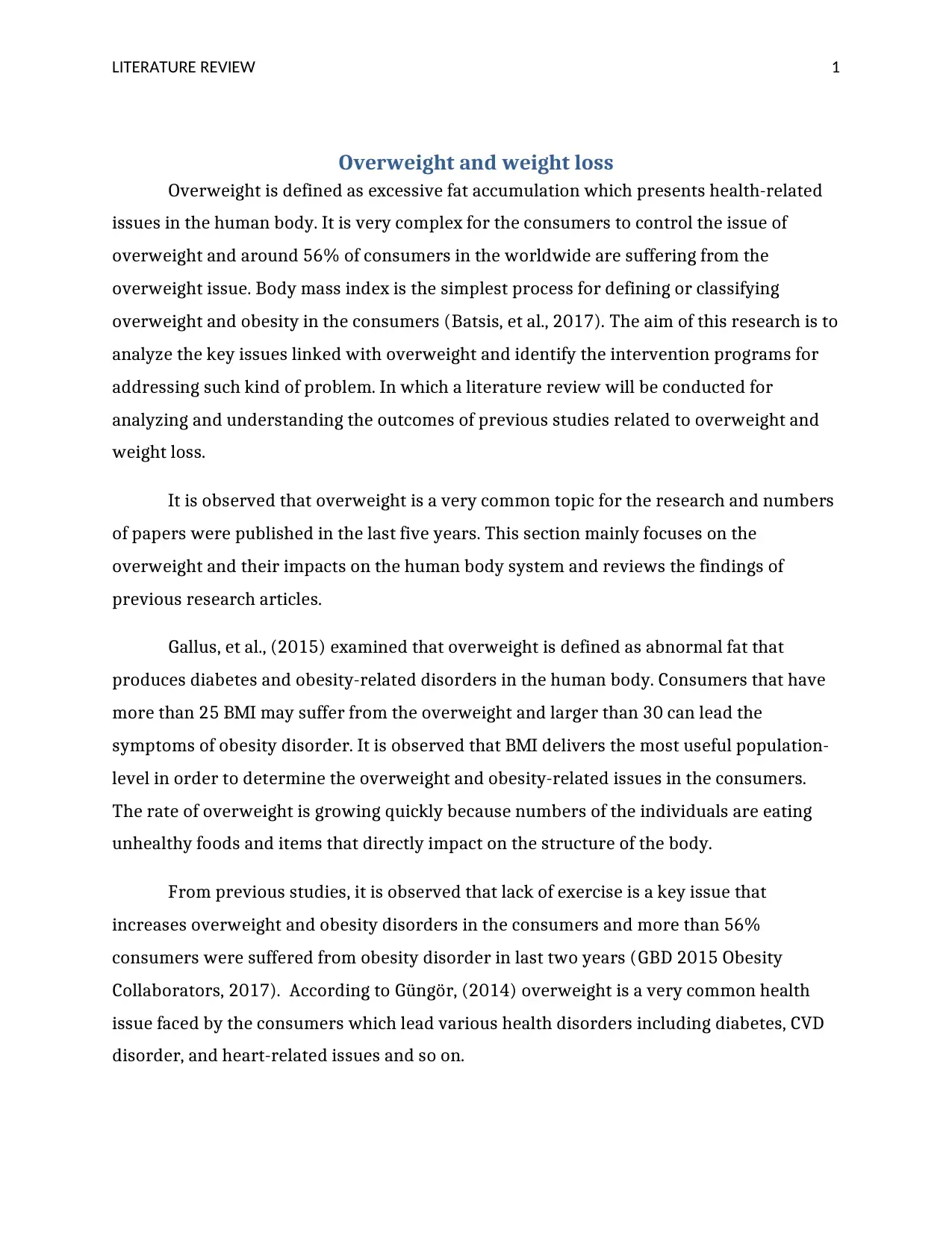
LITERATURE REVIEW 1
Overweight and weight loss
Overweight is defined as excessive fat accumulation which presents health-related
issues in the human body. It is very complex for the consumers to control the issue of
overweight and around 56% of consumers in the worldwide are suffering from the
overweight issue. Body mass index is the simplest process for defining or classifying
overweight and obesity in the consumers (Batsis, et al., 2017). The aim of this research is to
analyze the key issues linked with overweight and identify the intervention programs for
addressing such kind of problem. In which a literature review will be conducted for
analyzing and understanding the outcomes of previous studies related to overweight and
weight loss.
It is observed that overweight is a very common topic for the research and numbers
of papers were published in the last five years. This section mainly focuses on the
overweight and their impacts on the human body system and reviews the findings of
previous research articles.
Gallus, et al., (2015) examined that overweight is defined as abnormal fat that
produces diabetes and obesity-related disorders in the human body. Consumers that have
more than 25 BMI may suffer from the overweight and larger than 30 can lead the
symptoms of obesity disorder. It is observed that BMI delivers the most useful population-
level in order to determine the overweight and obesity-related issues in the consumers.
The rate of overweight is growing quickly because numbers of the individuals are eating
unhealthy foods and items that directly impact on the structure of the body.
From previous studies, it is observed that lack of exercise is a key issue that
increases overweight and obesity disorders in the consumers and more than 56%
consumers were suffered from obesity disorder in last two years (GBD 2015 Obesity
Collaborators, 2017). According to Güngör, (2014) overweight is a very common health
issue faced by the consumers which lead various health disorders including diabetes, CVD
disorder, and heart-related issues and so on.
Overweight and weight loss
Overweight is defined as excessive fat accumulation which presents health-related
issues in the human body. It is very complex for the consumers to control the issue of
overweight and around 56% of consumers in the worldwide are suffering from the
overweight issue. Body mass index is the simplest process for defining or classifying
overweight and obesity in the consumers (Batsis, et al., 2017). The aim of this research is to
analyze the key issues linked with overweight and identify the intervention programs for
addressing such kind of problem. In which a literature review will be conducted for
analyzing and understanding the outcomes of previous studies related to overweight and
weight loss.
It is observed that overweight is a very common topic for the research and numbers
of papers were published in the last five years. This section mainly focuses on the
overweight and their impacts on the human body system and reviews the findings of
previous research articles.
Gallus, et al., (2015) examined that overweight is defined as abnormal fat that
produces diabetes and obesity-related disorders in the human body. Consumers that have
more than 25 BMI may suffer from the overweight and larger than 30 can lead the
symptoms of obesity disorder. It is observed that BMI delivers the most useful population-
level in order to determine the overweight and obesity-related issues in the consumers.
The rate of overweight is growing quickly because numbers of the individuals are eating
unhealthy foods and items that directly impact on the structure of the body.
From previous studies, it is observed that lack of exercise is a key issue that
increases overweight and obesity disorders in the consumers and more than 56%
consumers were suffered from obesity disorder in last two years (GBD 2015 Obesity
Collaborators, 2017). According to Güngör, (2014) overweight is a very common health
issue faced by the consumers which lead various health disorders including diabetes, CVD
disorder, and heart-related issues and so on.
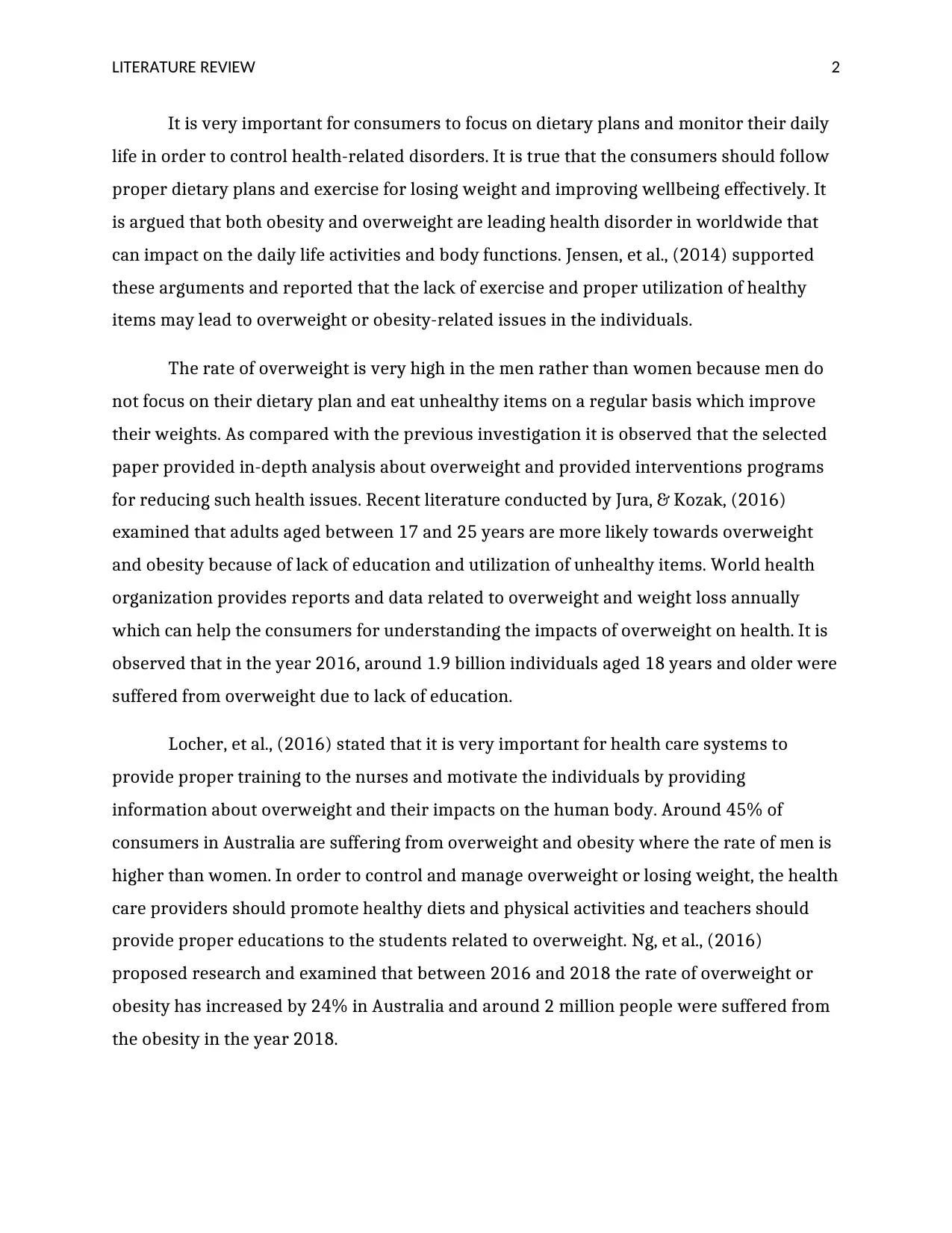
LITERATURE REVIEW 2
It is very important for consumers to focus on dietary plans and monitor their daily
life in order to control health-related disorders. It is true that the consumers should follow
proper dietary plans and exercise for losing weight and improving wellbeing effectively. It
is argued that both obesity and overweight are leading health disorder in worldwide that
can impact on the daily life activities and body functions. Jensen, et al., (2014) supported
these arguments and reported that the lack of exercise and proper utilization of healthy
items may lead to overweight or obesity-related issues in the individuals.
The rate of overweight is very high in the men rather than women because men do
not focus on their dietary plan and eat unhealthy items on a regular basis which improve
their weights. As compared with the previous investigation it is observed that the selected
paper provided in-depth analysis about overweight and provided interventions programs
for reducing such health issues. Recent literature conducted by Jura, & Kozak, (2016)
examined that adults aged between 17 and 25 years are more likely towards overweight
and obesity because of lack of education and utilization of unhealthy items. World health
organization provides reports and data related to overweight and weight loss annually
which can help the consumers for understanding the impacts of overweight on health. It is
observed that in the year 2016, around 1.9 billion individuals aged 18 years and older were
suffered from overweight due to lack of education.
Locher, et al., (2016) stated that it is very important for health care systems to
provide proper training to the nurses and motivate the individuals by providing
information about overweight and their impacts on the human body. Around 45% of
consumers in Australia are suffering from overweight and obesity where the rate of men is
higher than women. In order to control and manage overweight or losing weight, the health
care providers should promote healthy diets and physical activities and teachers should
provide proper educations to the students related to overweight. Ng, et al., (2016)
proposed research and examined that between 2016 and 2018 the rate of overweight or
obesity has increased by 24% in Australia and around 2 million people were suffered from
the obesity in the year 2018.
It is very important for consumers to focus on dietary plans and monitor their daily
life in order to control health-related disorders. It is true that the consumers should follow
proper dietary plans and exercise for losing weight and improving wellbeing effectively. It
is argued that both obesity and overweight are leading health disorder in worldwide that
can impact on the daily life activities and body functions. Jensen, et al., (2014) supported
these arguments and reported that the lack of exercise and proper utilization of healthy
items may lead to overweight or obesity-related issues in the individuals.
The rate of overweight is very high in the men rather than women because men do
not focus on their dietary plan and eat unhealthy items on a regular basis which improve
their weights. As compared with the previous investigation it is observed that the selected
paper provided in-depth analysis about overweight and provided interventions programs
for reducing such health issues. Recent literature conducted by Jura, & Kozak, (2016)
examined that adults aged between 17 and 25 years are more likely towards overweight
and obesity because of lack of education and utilization of unhealthy items. World health
organization provides reports and data related to overweight and weight loss annually
which can help the consumers for understanding the impacts of overweight on health. It is
observed that in the year 2016, around 1.9 billion individuals aged 18 years and older were
suffered from overweight due to lack of education.
Locher, et al., (2016) stated that it is very important for health care systems to
provide proper training to the nurses and motivate the individuals by providing
information about overweight and their impacts on the human body. Around 45% of
consumers in Australia are suffering from overweight and obesity where the rate of men is
higher than women. In order to control and manage overweight or losing weight, the health
care providers should promote healthy diets and physical activities and teachers should
provide proper educations to the students related to overweight. Ng, et al., (2016)
proposed research and examined that between 2016 and 2018 the rate of overweight or
obesity has increased by 24% in Australia and around 2 million people were suffered from
the obesity in the year 2018.
⊘ This is a preview!⊘
Do you want full access?
Subscribe today to unlock all pages.

Trusted by 1+ million students worldwide
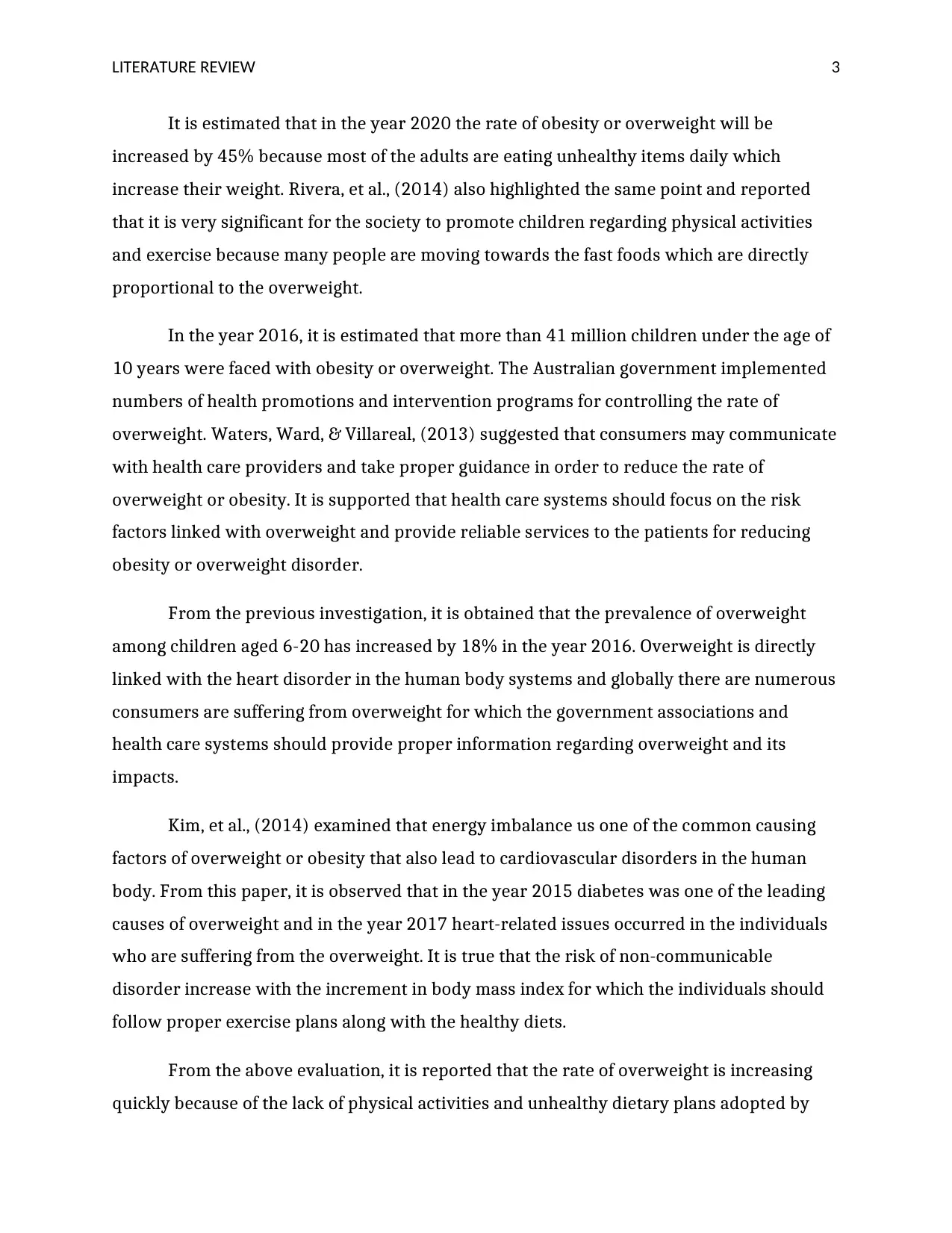
LITERATURE REVIEW 3
It is estimated that in the year 2020 the rate of obesity or overweight will be
increased by 45% because most of the adults are eating unhealthy items daily which
increase their weight. Rivera, et al., (2014) also highlighted the same point and reported
that it is very significant for the society to promote children regarding physical activities
and exercise because many people are moving towards the fast foods which are directly
proportional to the overweight.
In the year 2016, it is estimated that more than 41 million children under the age of
10 years were faced with obesity or overweight. The Australian government implemented
numbers of health promotions and intervention programs for controlling the rate of
overweight. Waters, Ward, & Villareal, (2013) suggested that consumers may communicate
with health care providers and take proper guidance in order to reduce the rate of
overweight or obesity. It is supported that health care systems should focus on the risk
factors linked with overweight and provide reliable services to the patients for reducing
obesity or overweight disorder.
From the previous investigation, it is obtained that the prevalence of overweight
among children aged 6-20 has increased by 18% in the year 2016. Overweight is directly
linked with the heart disorder in the human body systems and globally there are numerous
consumers are suffering from overweight for which the government associations and
health care systems should provide proper information regarding overweight and its
impacts.
Kim, et al., (2014) examined that energy imbalance us one of the common causing
factors of overweight or obesity that also lead to cardiovascular disorders in the human
body. From this paper, it is observed that in the year 2015 diabetes was one of the leading
causes of overweight and in the year 2017 heart-related issues occurred in the individuals
who are suffering from the overweight. It is true that the risk of non-communicable
disorder increase with the increment in body mass index for which the individuals should
follow proper exercise plans along with the healthy diets.
From the above evaluation, it is reported that the rate of overweight is increasing
quickly because of the lack of physical activities and unhealthy dietary plans adopted by
It is estimated that in the year 2020 the rate of obesity or overweight will be
increased by 45% because most of the adults are eating unhealthy items daily which
increase their weight. Rivera, et al., (2014) also highlighted the same point and reported
that it is very significant for the society to promote children regarding physical activities
and exercise because many people are moving towards the fast foods which are directly
proportional to the overweight.
In the year 2016, it is estimated that more than 41 million children under the age of
10 years were faced with obesity or overweight. The Australian government implemented
numbers of health promotions and intervention programs for controlling the rate of
overweight. Waters, Ward, & Villareal, (2013) suggested that consumers may communicate
with health care providers and take proper guidance in order to reduce the rate of
overweight or obesity. It is supported that health care systems should focus on the risk
factors linked with overweight and provide reliable services to the patients for reducing
obesity or overweight disorder.
From the previous investigation, it is obtained that the prevalence of overweight
among children aged 6-20 has increased by 18% in the year 2016. Overweight is directly
linked with the heart disorder in the human body systems and globally there are numerous
consumers are suffering from overweight for which the government associations and
health care systems should provide proper information regarding overweight and its
impacts.
Kim, et al., (2014) examined that energy imbalance us one of the common causing
factors of overweight or obesity that also lead to cardiovascular disorders in the human
body. From this paper, it is observed that in the year 2015 diabetes was one of the leading
causes of overweight and in the year 2017 heart-related issues occurred in the individuals
who are suffering from the overweight. It is true that the risk of non-communicable
disorder increase with the increment in body mass index for which the individuals should
follow proper exercise plans along with the healthy diets.
From the above evaluation, it is reported that the rate of overweight is increasing
quickly because of the lack of physical activities and unhealthy dietary plans adopted by
Paraphrase This Document
Need a fresh take? Get an instant paraphrase of this document with our AI Paraphraser
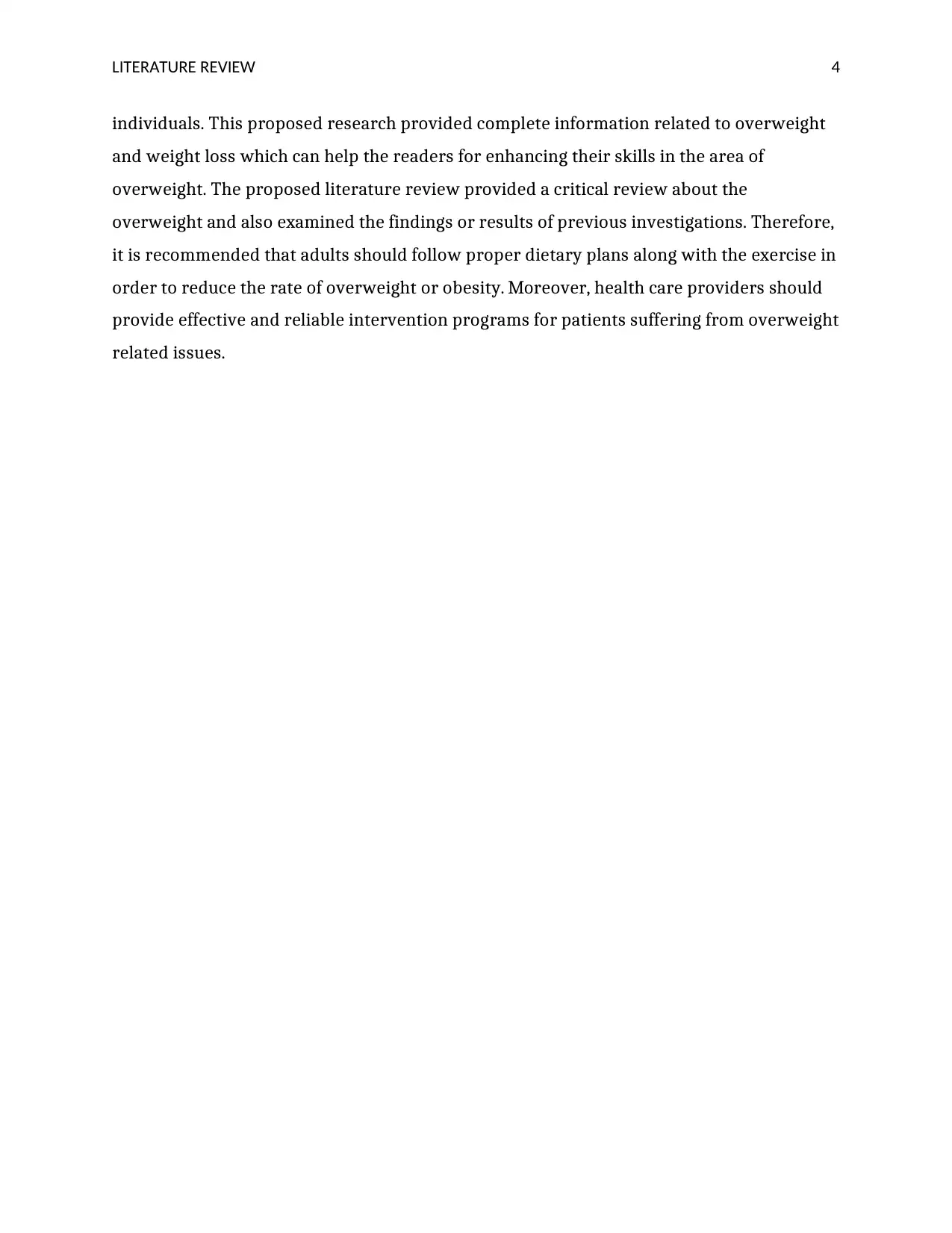
LITERATURE REVIEW 4
individuals. This proposed research provided complete information related to overweight
and weight loss which can help the readers for enhancing their skills in the area of
overweight. The proposed literature review provided a critical review about the
overweight and also examined the findings or results of previous investigations. Therefore,
it is recommended that adults should follow proper dietary plans along with the exercise in
order to reduce the rate of overweight or obesity. Moreover, health care providers should
provide effective and reliable intervention programs for patients suffering from overweight
related issues.
individuals. This proposed research provided complete information related to overweight
and weight loss which can help the readers for enhancing their skills in the area of
overweight. The proposed literature review provided a critical review about the
overweight and also examined the findings or results of previous investigations. Therefore,
it is recommended that adults should follow proper dietary plans along with the exercise in
order to reduce the rate of overweight or obesity. Moreover, health care providers should
provide effective and reliable intervention programs for patients suffering from overweight
related issues.
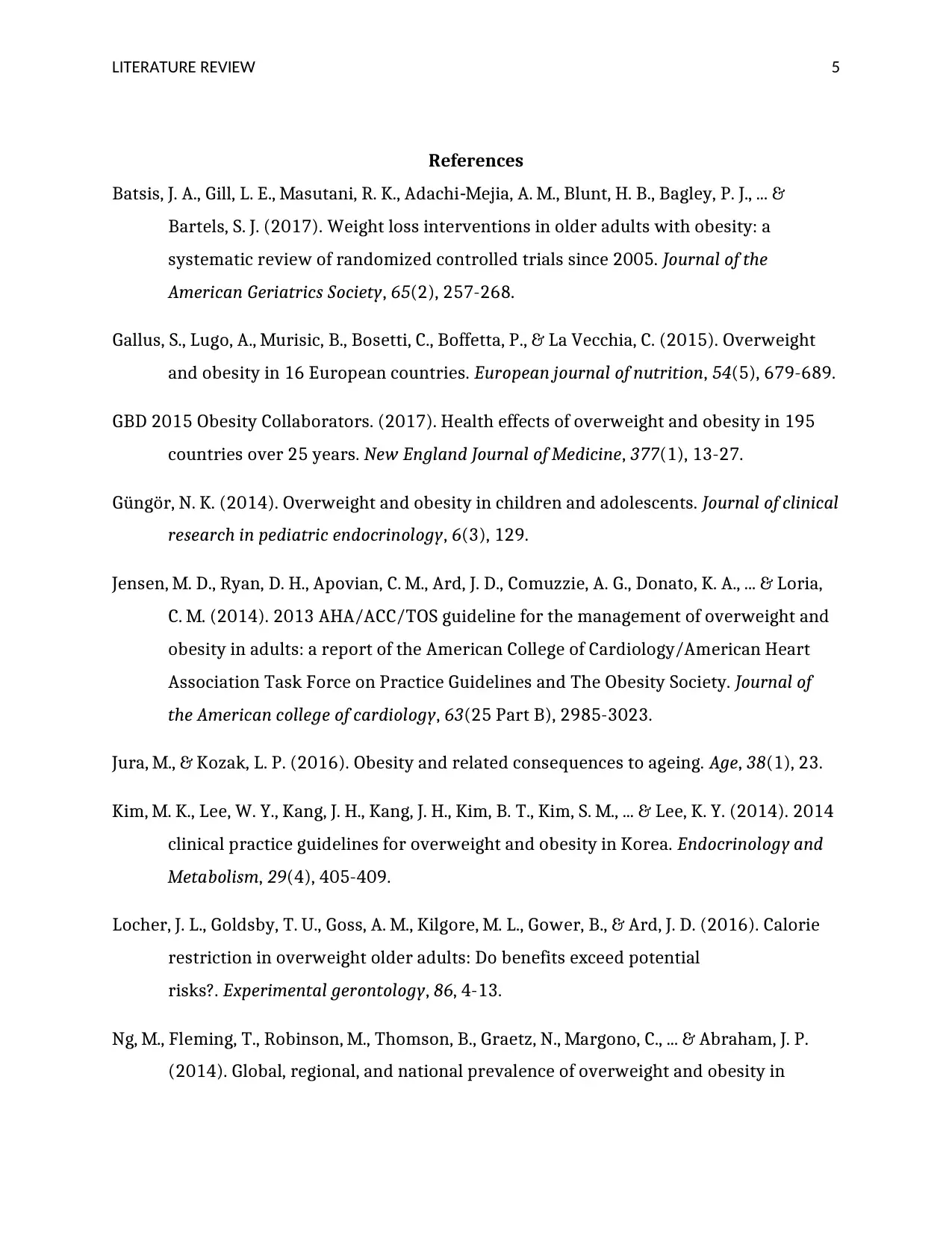
LITERATURE REVIEW 5
References
Batsis, J. A., Gill, L. E., Masutani, R. K., Adachi‐Mejia, A. M., Blunt, H. B., Bagley, P. J., ... &
Bartels, S. J. (2017). Weight loss interventions in older adults with obesity: a
systematic review of randomized controlled trials since 2005. Journal of the
American Geriatrics Society, 65(2), 257-268.
Gallus, S., Lugo, A., Murisic, B., Bosetti, C., Boffetta, P., & La Vecchia, C. (2015). Overweight
and obesity in 16 European countries. European journal of nutrition, 54(5), 679-689.
GBD 2015 Obesity Collaborators. (2017). Health effects of overweight and obesity in 195
countries over 25 years. New England Journal of Medicine, 377(1), 13-27.
Güngör, N. K. (2014). Overweight and obesity in children and adolescents. Journal of clinical
research in pediatric endocrinology, 6(3), 129.
Jensen, M. D., Ryan, D. H., Apovian, C. M., Ard, J. D., Comuzzie, A. G., Donato, K. A., ... & Loria,
C. M. (2014). 2013 AHA/ACC/TOS guideline for the management of overweight and
obesity in adults: a report of the American College of Cardiology/American Heart
Association Task Force on Practice Guidelines and The Obesity Society. Journal of
the American college of cardiology, 63(25 Part B), 2985-3023.
Jura, M., & Kozak, L. P. (2016). Obesity and related consequences to ageing. Age, 38(1), 23.
Kim, M. K., Lee, W. Y., Kang, J. H., Kang, J. H., Kim, B. T., Kim, S. M., ... & Lee, K. Y. (2014). 2014
clinical practice guidelines for overweight and obesity in Korea. Endocrinology and
Metabolism, 29(4), 405-409.
Locher, J. L., Goldsby, T. U., Goss, A. M., Kilgore, M. L., Gower, B., & Ard, J. D. (2016). Calorie
restriction in overweight older adults: Do benefits exceed potential
risks?. Experimental gerontology, 86, 4-13.
Ng, M., Fleming, T., Robinson, M., Thomson, B., Graetz, N., Margono, C., ... & Abraham, J. P.
(2014). Global, regional, and national prevalence of overweight and obesity in
References
Batsis, J. A., Gill, L. E., Masutani, R. K., Adachi‐Mejia, A. M., Blunt, H. B., Bagley, P. J., ... &
Bartels, S. J. (2017). Weight loss interventions in older adults with obesity: a
systematic review of randomized controlled trials since 2005. Journal of the
American Geriatrics Society, 65(2), 257-268.
Gallus, S., Lugo, A., Murisic, B., Bosetti, C., Boffetta, P., & La Vecchia, C. (2015). Overweight
and obesity in 16 European countries. European journal of nutrition, 54(5), 679-689.
GBD 2015 Obesity Collaborators. (2017). Health effects of overweight and obesity in 195
countries over 25 years. New England Journal of Medicine, 377(1), 13-27.
Güngör, N. K. (2014). Overweight and obesity in children and adolescents. Journal of clinical
research in pediatric endocrinology, 6(3), 129.
Jensen, M. D., Ryan, D. H., Apovian, C. M., Ard, J. D., Comuzzie, A. G., Donato, K. A., ... & Loria,
C. M. (2014). 2013 AHA/ACC/TOS guideline for the management of overweight and
obesity in adults: a report of the American College of Cardiology/American Heart
Association Task Force on Practice Guidelines and The Obesity Society. Journal of
the American college of cardiology, 63(25 Part B), 2985-3023.
Jura, M., & Kozak, L. P. (2016). Obesity and related consequences to ageing. Age, 38(1), 23.
Kim, M. K., Lee, W. Y., Kang, J. H., Kang, J. H., Kim, B. T., Kim, S. M., ... & Lee, K. Y. (2014). 2014
clinical practice guidelines for overweight and obesity in Korea. Endocrinology and
Metabolism, 29(4), 405-409.
Locher, J. L., Goldsby, T. U., Goss, A. M., Kilgore, M. L., Gower, B., & Ard, J. D. (2016). Calorie
restriction in overweight older adults: Do benefits exceed potential
risks?. Experimental gerontology, 86, 4-13.
Ng, M., Fleming, T., Robinson, M., Thomson, B., Graetz, N., Margono, C., ... & Abraham, J. P.
(2014). Global, regional, and national prevalence of overweight and obesity in
⊘ This is a preview!⊘
Do you want full access?
Subscribe today to unlock all pages.

Trusted by 1+ million students worldwide
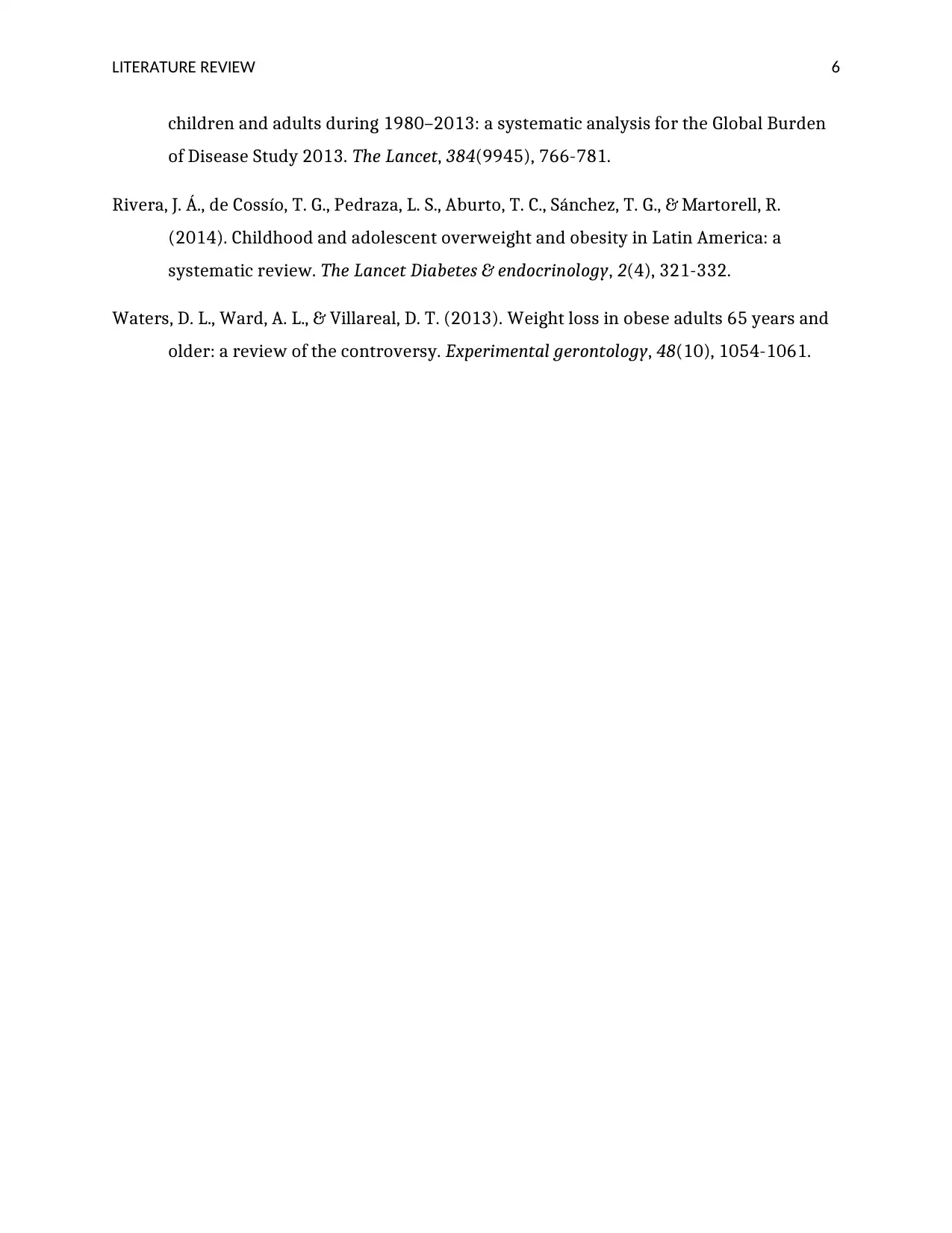
LITERATURE REVIEW 6
children and adults during 1980–2013: a systematic analysis for the Global Burden
of Disease Study 2013. The Lancet, 384(9945), 766-781.
Rivera, J. Á., de Cossío, T. G., Pedraza, L. S., Aburto, T. C., Sánchez, T. G., & Martorell, R.
(2014). Childhood and adolescent overweight and obesity in Latin America: a
systematic review. The Lancet Diabetes & endocrinology, 2(4), 321-332.
Waters, D. L., Ward, A. L., & Villareal, D. T. (2013). Weight loss in obese adults 65 years and
older: a review of the controversy. Experimental gerontology, 48(10), 1054-1061.
children and adults during 1980–2013: a systematic analysis for the Global Burden
of Disease Study 2013. The Lancet, 384(9945), 766-781.
Rivera, J. Á., de Cossío, T. G., Pedraza, L. S., Aburto, T. C., Sánchez, T. G., & Martorell, R.
(2014). Childhood and adolescent overweight and obesity in Latin America: a
systematic review. The Lancet Diabetes & endocrinology, 2(4), 321-332.
Waters, D. L., Ward, A. L., & Villareal, D. T. (2013). Weight loss in obese adults 65 years and
older: a review of the controversy. Experimental gerontology, 48(10), 1054-1061.
1 out of 7
Related Documents
Your All-in-One AI-Powered Toolkit for Academic Success.
+13062052269
info@desklib.com
Available 24*7 on WhatsApp / Email
![[object Object]](/_next/static/media/star-bottom.7253800d.svg)
Unlock your academic potential
Copyright © 2020–2025 A2Z Services. All Rights Reserved. Developed and managed by ZUCOL.





